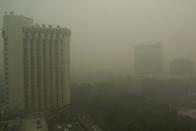
Stats
Work interests: research, editing, science communication
Affiliation/website: National Museum of Ethnology, Osaka
Preferred contact method: Any
Preferred contact language(s): English, German
Contact: email = researchcooperative-at-gmail-dot-com
Favourite publications: Various, and especially the open access versions of older journals with effective review systems
Founding Member
Affiliations: 1996-present: National Museum of Ethnology, Osaka. 1995: Freelance editor, Kyoto. 1994: JSPS Research Visitor, Kyoto University, Kyoto. 1993: Research Visitor, Australian National University, Canberra. 1991: Visiting Researcher, National Museum of Ethnology, Osaka.1990: STA Fellow, National Institute for Ornamental Plants, Vegetables, and Tea (NIVOT), Ano, Japan
Contact: National Museum of Ethnology, Senri Expo Park, Suita City, Osaka, Japan 565-8511
Biographical: Established the Research Cooperative in 2001
Favourite Publications: Various
The worst smog and two conferences in New Delhi
Here I am recovering from flu on the 12th floor of a hotel overlooking the center of the capital of India. From my window I can see barely 200 m. It is the worst smog in this city in 17 years, according to the local news reports.
The vague silhouettes of two large hawks glide by about 50 m away. I suspect there is no chance of them spying food on the ground from this height.
About 1km away, far out of view, the biennial Asian Ministerial Conference on Disaster Risk Reduction is taking place at th e Vigyan Bhawan Conference Centre.
Why is it so difficult for societies to prevent human-made disasters such as smog? If we cannot deal with the simplest and most obvious of dangers, created by our own local actions, how can we possibly deal with global disasters such as rapid climate change?

Neither is visible though merely 1-2 km distant. (PJM 5th November 2016).
I am waiting for the start of the 1st International Agrobiodiversity Conference, 6. - 9. Nov. 2016, here in New Delhi. There will be many papers concerned with serious issues, but I wonder if we can have an emergency session on the role of agrobiodiversity in reducing CO2 emissions in forestry and agriculture?
One of the causes of the current smog in New Delhi is the burning of crop residues by farmers in neighbouring regions of Northern India. This is an old practice, so it should not be a scapegoat for the present crisis. What is new is the addition of car and truck traffic and poorly controlled use of diesel powered vehicles. Neverthless, we should ask if crop management practices can be changed to help reduce the smog. Can crop stubble be transformed into high value products such as fermented fertilisers, or energy for carbon-neutral transport or farm machinery?
Farmers have many reasons to burn crop stubble. Ash has a direct benefit for soil, and burning also helps to break the life-cycles of some pests and diseases. The human labour or machinery needed for field management is less with fire than with other methods of removing and treating stubble. Burning may reduce the need for expensive agrichemicals to manage field hygiene. Burning is part of an established complex system, and changing the process would have many downstream consequences. To replace burning with other methods requries a lot of thought about the entire food production system and how all the parts integrate with each other.
Ideally, biologically-diverse agroforestry systems that do not require burning can add value to unburnt straw from cereal crops, can be more productive, and can support the human, animal, and mechanical requirements needed for their operation, as well as creating surplus for use by urban populations.
That's an ideal - but can such an alternative be created to the current open, mono-cultural field systems of northern India? It is no use telling farmers to stop burning without providing incentives and practical models that can replace current practices.
Should we be holding a joint session on environmental risk management and agrobiodiversity?
Are there any Ministers willing to gate-crash the Agrobiodiversity party? Are there any Agriculturalists willing to gate-crash the Risk-Reduction party? Or do we all party on, in our separate spheres of interest, while the world burns around us?
I am breathing the same air as those birds outside, for a few days.
Fortunately for me, I can fly further and faster to escape this immediate problem, but I am contributing much more to the problem than they are. For their sake, and for sake of people who must perservere in conditions like this, I hope I can learn something useful over the next few days, and apply this to my work as a crop historian and science writer.











